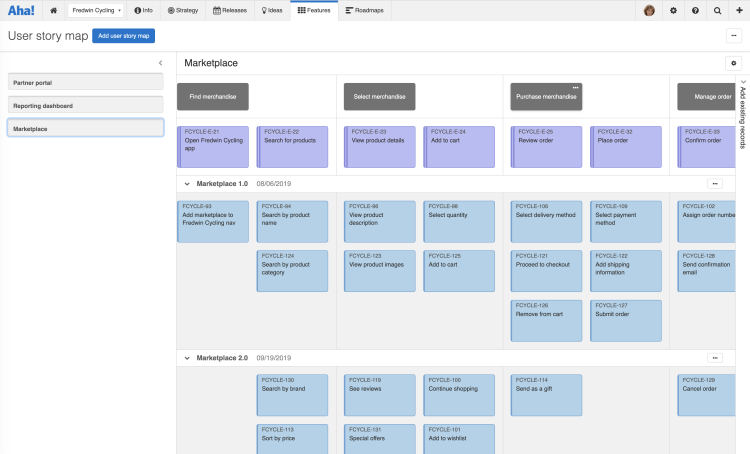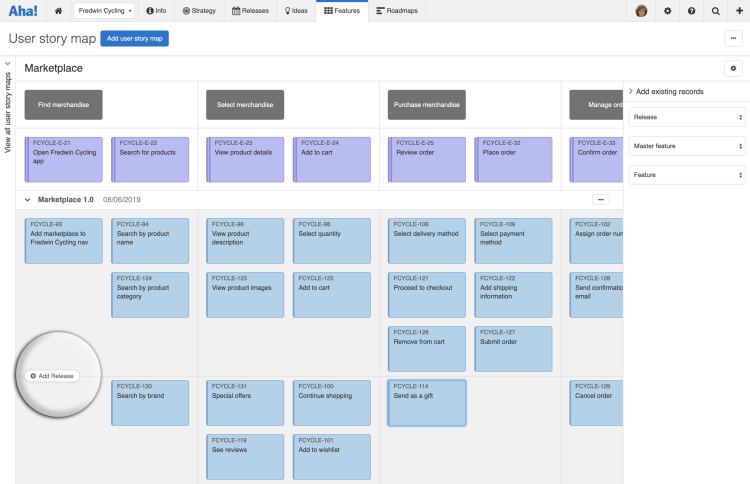
Just Launched! — New User Story Mapping Tool in Aha!
Product and marketing teams love user story maps. How do we know? Because it is the second most popular item in our ideas portal. Many of you told us you wanted a better way to align your roadmap with the user and buyer journey. We agreed. And after quite a bit of journey mapping on our end, we are excited to introduce this important functionality so you can do just that.
You can now create user story maps in Aha! to align your roadmap with your customer’s journey.
The new user story map is the perfect complement to the features board. The board allows you to plan based on upcoming releases, work which tends to be inward-focused. The story map enables you to create and prioritize work based on what your customer is trying to do, which is externally-focused. Both views are useful for building an optimal roadmap that delivers the most value for customers and the team.
Creating a story map is a familiar exercise for most product teams. It gives you a way to visualize and organize the high-level activities by the tasks your users are trying to complete. Grouping new functionality that you are going to build this way helps you understand which features will provide the most value to your customers and prioritize accordingly.
Although perhaps a bit newer to marketing teams, story maps are incredibly useful for your work too. You can visualize the buyer’s journey to better understand what information and support customers need at each stage to purchase your product or service.
All product and marketing workspaces in Aha! include user story maps. If you have customized your navigation, you will need to enable user story maps in your navigation settings. This new view is especially helpful during planning sessions because you can map the ideal user flow and capture ideas as you go. Quickly add master features and features (you might call these epics and stories) to see where they fit in the context of the user journey. If you are in a marketing workspace, these records are labeled as master activities and activities.
The examples below use terminology from a product workspace. Here is how to get started:
Capture the user journey Consider the steps someone needs to take as they try to solve a problem and use your product. Add these to your story map from left to right. Then add master features. These are larger bodies of work that you can use to group high-level activities or actions the user is trying to complete as part of each step. The example below shows how users would find, select, and purchase merchandise in an ecommerce store.
If you are not currently using master features, adding one to your user story map automatically enables the functionality in your workspace settings.
Map features to each step Now you are ready to add features. You can create new features as you go or add existing records. Then you can drag and drop the cards in priority order. This way you can see which features will improve the user experience and which ones are not fundamental to helping the customer solve a key challenge.
Features will automatically link to the corresponding master feature in each column.
Plan upcoming releases You can also add releases (both new and existing) to your user story map. Adding a release inserts a horizontal swimlane across all steps — so you can see when you plan to deliver the new functionality. As work gets underway, you also have the option to color the cards by status to track their progress.

You can share your user story map as a notebook, image, or PDF.
Viewing your product roadmap from a user’s perspective lets you focus on building what your customers really need.
If you have been waiting for user story maps to make it into Aha! — today is your day. Go ahead, start mapping. (And if you have not worked with user story maps before, this guide will help you think about how to incorporate them into your work.)
Sign up for a free Aha! trial — be happy User story maps are available to all Aha! customers. If you are not already an Aha! customer, you may want to sign up for a free 30-day trial or join a live demo to see why more than 250,000 users trust Aha! to build and market lovable products.
